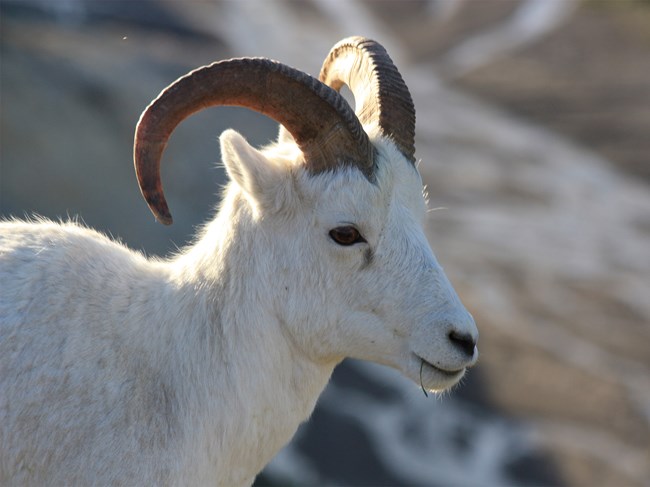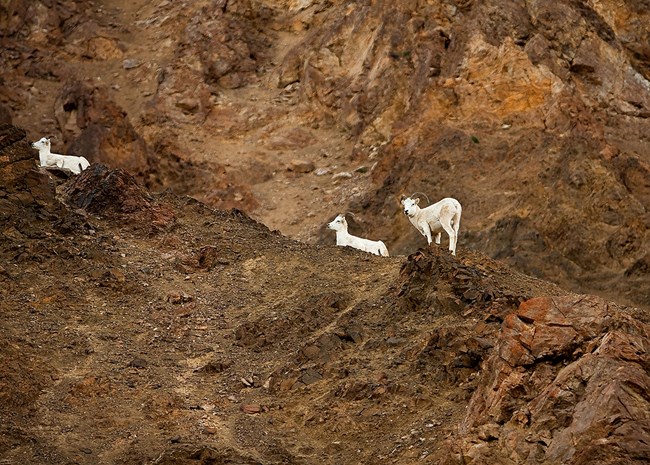Last updated: July 24, 2018
Article
Monitoring Dall Sheep in Denali

NPS Photo
Observers have long been impressed by these characteristics. In fact, it was a desire to protect the local Dall sheep population that spurred conservationist Charles Sheldon to lobby for what has become Denali National Park and Preserve.
The park's Dall sheep population is still of unique interest to wildlife managers. It is one of the few populations in North America that is not currently hunted and shares its range with a natural component of large predators.

Surveying Efforts in the Park
Monitoring Dall sheep populations throughout their range is important to Alaskans and state and federal agencies. Data of interest includes trends in abundance, distribution, sex, and age. Dall sheep productivity (i.e. lamb survival) is also monitored.
In Denali National Park and Preserve, this is done through a combination of ground and aerial surveys. Ground surveys occurred from 1974-1996 and from 2008-2018. Aerial surveys occurred in 2011 and from 2015-2018.
Ground Surveys
Ground surveys are carried out in early June, after snow has melted but before lambs have grown too large to be easily identified and before sheep move to summering grounds. Ground survey teams use spotting scopes and binoculars to survey Dall sheep in several locations along the Denali Park Road. Surveying teams record the number of sheep observed, classify by age and sex, and record the location where the sheep were observed.
While limited in geographic extent, ground surveys provide detailed observation of Dall sheep band composition. The results of ground surveys may not be applicable to the entire sheep population of Denali, but are a useful indicator of year-to-year changes, particularly for lamb to ewe ratios.

Ewes generally have their first lamb at age three and produce one lamb annually. The observed lamb to ewe ratio is a measure of the “productivity” of the population and is important for understanding changes in the population over time. Winter and spring snow conditions can dramatically influence sheep productivity. For example, an unusual spring in 2013 resulted in snow cover that remained well past normal “snow-off” dates throughout Dall sheep range in Alaska. As a result, sheep productivity was low in several areas. Based on ground surveys, the lamb:ewe ratio was 3:100 in 2013, compared to an average of 43:100 from 1974 to 2018.

NPS Image
Aerial Surveys
Aerial surveys provide a way to estimate the population size and composition (ewes, lambs, and rams) of Dall sheep across a large study area. In Denali, these surveys typically take place over a few days in late July. Small planes with trained pilots and one observer transverse established transect lines in Dall sheep habitat and record group size and group composition of all observed bands of sheep. Later, biologists employ statistical analyses to estimate total population size.
Aerial surveys cover a far larger area than ground surveys and allow for monitoring of population changes of Dall sheep within the park.
Dall sheep population has fluctuated over observation years. Total population in 2011 was estimated at 2,288 sheep. Decline, likely related to 2013’s long lasting snow cover, resulted in a 16-17% population reduction by 2015. Denali's Dall sheep bands seem to be making a comeback however, as a population of 1,530 sheep was estimated by the 2017 aerial survey.

NPS Image

Monitoring Implications
Continued ground and aerial monitoring of Denali's Dall sheep informs wildlife management decisions. As a potential indicator of environmental change and an important species for subsistence and sport hunting, Dall sheep capture our attention just as thoroughly as they did Charles Sheldon's. Increased understanding of their population dynamics will ensure future park visitors can still marvel at those small, white dots hanging on the mountainside.
